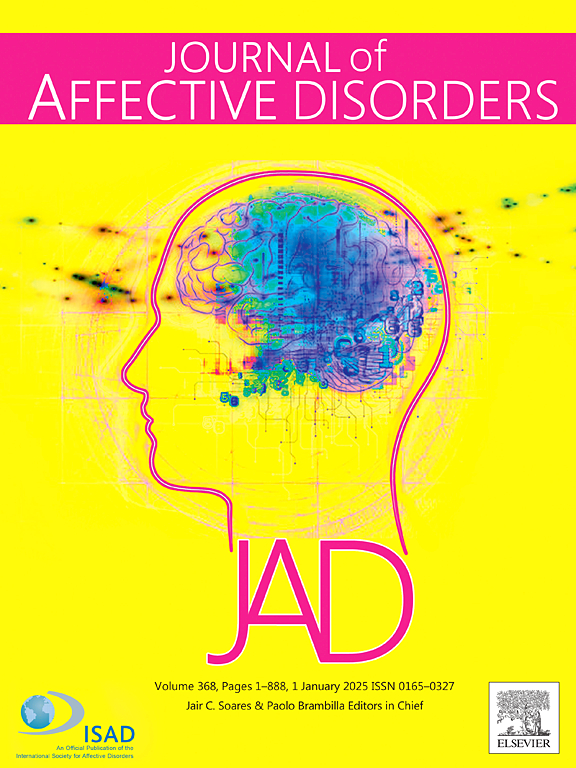The association between local public health unit funding and adolescent mental health during the COVID-19 pandemic: Longitudinal findings from the Ontario public health information database (OPHID) and COMPASS studies
IF 4.9
2区 医学
Q1 CLINICAL NEUROLOGY
引用次数: 0
Abstract
Background
Public health units (PHU) require adequate funding to service the needs of their community. This study examined the association between PHU funding and adolescent mental health trajectories from 2018–19 to 2020–21 in Ontario, Canada.
Methods
Longitudinal adolescent data from the Cannabis, Obesity, Mental health, Physical activity, Alcohol, Smoking, and Sedentary behaviour (COMPASS) study (n = 6043) was used. Adolescents reported on depression and anxiety symptoms via questionnaire. Data on funding from 12 PHUs was obtained from the Ontario Public Health Information Database. We used multilevel growth curve analyses to estimate whether PHU funding modified trajectories of depressive and anxiety symptoms while adjusting for student, school, and area-level covariates. We also tested for heterogeneity by gender and performed gender stratified analyses.
Results
PHU funding modified depression trajectories. Differences in depression scores by level of PHU funding were not significant at each time point. However, students attending schools in areas with lower PHU funding had smaller rates of growth in depression from 2018–19 to 2019–20 (Low PHU: ∂ = 0.50, 95 % CI: 0.27, 0.74; High PHU: ∂ = 1.10, 95 % CI: 0.81, 1.39), but larger rates of growth from 2019–20 to 2020–21 (Low PHU: ∂ = 1.66, 95 % CI: 1.32, 2.00; High PHU: ∂ = 0.70, 95 % CI: 0.35, 1.05). Findings were similar in female stratified models. PHU funding did not modify anxiety trajectories.
Conclusion
Trajectories of adolescent depression symptoms, particularly females, during the COVID-19 pandemic may have been modified by the level of PHU funding. More research over a longer period and in different jurisdictions is needed.
2019冠状病毒病大流行期间当地公共卫生单位资金与青少年心理健康之间的关系:安大略省公共卫生信息数据库(OPHID)和COMPASS研究的纵向研究结果。
背景:公共卫生单位(PHU)需要足够的资金来满足其社区的需求。本研究调查了加拿大安大略省2018年至2019年至2020-21年期间PHU资金与青少年心理健康轨迹之间的关系。方法:采用来自大麻、肥胖、心理健康、体育活动、酒精、吸烟和久坐行为(COMPASS)研究(n = 6043)的纵向青少年数据。青少年通过问卷调查报告抑郁和焦虑症状。来自12个初级保健单位的资金数据来自安大略省公共卫生信息数据库。我们使用多水平增长曲线分析来估计PHU资助是否在调整学生、学校和地区水平协变量时改变了抑郁和焦虑症状的轨迹。我们还测试了性别的异质性,并进行了性别分层分析。结果:PHU资助改变了抑郁轨迹。在每个时间点,PHU资助水平的抑郁评分差异不显著。然而,在PHU资助较少的地区上学的学生在2018年至2019年至2019年期间的抑郁症增长率较小(低PHU:∂ = 0.50,95 % CI: 0.27, 0.74;高PHU:∂ = 1.10,95 % CI: 0.81, 1.39),但从2019年到2020年到2020-21年的增长率较大(低PHU:∂ = 1.66,95 % CI: 1.32, 2.00;高PHU:∂ = 0.70,95 % CI: 0.35, 1.05)。在女性分层模型中发现相似。PHU的资助并没有改变焦虑轨迹。结论:在COVID-19大流行期间,青少年(尤其是女性)抑郁症状的轨迹可能已被PHU的资助水平所改变。需要在更长时期和不同司法管辖区进行更多的研究。
本文章由计算机程序翻译,如有差异,请以英文原文为准。
求助全文
约1分钟内获得全文
求助全文
来源期刊

Journal of affective disorders
医学-精神病学
CiteScore
10.90
自引率
6.10%
发文量
1319
审稿时长
9.3 weeks
期刊介绍:
The Journal of Affective Disorders publishes papers concerned with affective disorders in the widest sense: depression, mania, mood spectrum, emotions and personality, anxiety and stress. It is interdisciplinary and aims to bring together different approaches for a diverse readership. Top quality papers will be accepted dealing with any aspect of affective disorders, including neuroimaging, cognitive neurosciences, genetics, molecular biology, experimental and clinical neurosciences, pharmacology, neuroimmunoendocrinology, intervention and treatment trials.
 求助内容:
求助内容: 应助结果提醒方式:
应助结果提醒方式:


